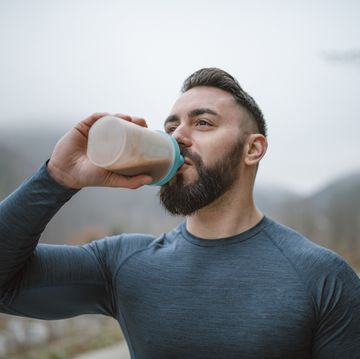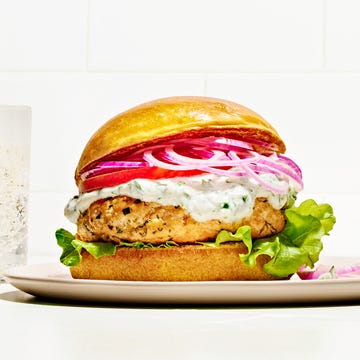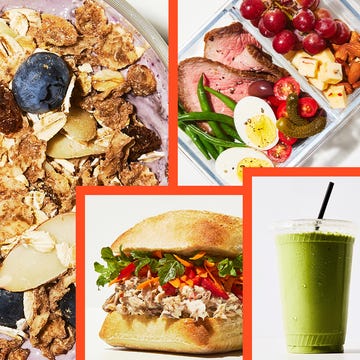Gregory Gourdet is the chef and founder of Kann and Sousòl in Portland, Oregon. He’s written the cookbook Everyone’s Table: Global Recipes for Modern Health and won three coveted James Beard Awards. But beyond his work in the kitchen, he’s also a dedicated and versatile athlete who has run marathons and ultra-marathons; knows his way equally around a CrossFit box and a yoga mat. This is his first essay in an exclusive new column for Men’s Health, called True Fuel, about the intersection of food and fitness.
WE’VE ALL BEEN there—rummaging through our gym bags for a Clif Bar post-workout or brushing off Nature Valley granola bar crumbs from our desks after a midday slump. We've choked down chalky protein shakes, grimaced through acrid monk fruit-sweetened treats, and gnawed on jerky so dry it could outlast the apocalypse.
So, where did we go wrong? Packaged health food dates back to the late 19th century when pioneers like William Post, James Kraft, and John Harvey Kellogg sought to improve food safety and nutrition. (Kellogg, who had previously run a sanatorium, created Corn Flakes to fight indigestion and designed them to be so dull they’d ward off sinful thoughts.) Ironically, their legacy brands, like Grape-nuts and American cheese, aren’t exactly models of modern health.
In the coming centuries, ultra-processed options took hold of the American diet. The thinking became: We could create "healthy" food products out of their component parts, piecing together macro- and micronutrients to make Frankenstein's monster versions of whole foods. Instead of fiber-packed fruits and veggies and lean, high-protein fish, and meat, industrial food engineers gave us an endless array of shakes and bars.
But now our understanding of nutrition is evolving, fitfully hurtling toward the modern consensus that whole foods are the gold standard for health.
The problem with so many fitness-focused snacks is that they’re still trapped in limbo somewhere between “healthy-ish” ingredients and ultra-processed mediocrity. These packaged products prioritize macros and shelf stability—which means that flavor and texture often suffer. Ingredients like protein isolates and fiber additives can create chalky, bitter, or overly dry products. To keep calories low, many brands sacrifice natural fats and sweeteners, which are key to making food taste good.
And yet the vast majority of "fitness fuel"—whether it's protein powder, energy bars, shot blocks, or gels—leans heavily toward the sweet side. There's a reason for this. Yes, sugar provides quick energy, and yes, we tend to favor sweet flavors. (Let’s be honest—it's a lot easier to market a "chocolate-peanut butter shake" than a "kale-quinoa" shake.)
But beyond taste and marketability, sweetness plays a functional role in health foods. It helps balance bitter and earthy flavors, making ingredients more palatable. Sugar also improves texture and acts as a preservative, extending the shelf life of these processed health foods.
In an ideal world, we’d all be biting into crisp fall apples, staining our fingers red with sun-warmed summer berries, tucking into steaming bowls of winter squash and ginger soup, or grilling gorgeous slabs of omega-3-rich salmon on the first warm day of spring. But what about when we’re on the go? Good news: The demand for better-tasting, whole-food fitness fuel has the market finally stepping up.
- Brands like Evolve, Koia, and Rebbl offer low-carb, high-fiber shakes that not only offer 20–32g of protein per serving but go down smooth. And they come in simple, clean flavors like “banana cream” and “cinnamon horchata.”
- Dairy-free folks can dig into Cocojune’s coconut yogurt, which is packed with probiotics–and with tangy flavor.
- Even the nut aisle has leveled up, enticing bored snackers with options like Thai curry cashews and chili-dusted roasted almonds.
- And yes, even Hormel has joined the movement, rolling out an all-natural line of nitrate-free, minimally processed meats.
I remember going on a run with Jeff Boggess, founder of Trail Butter. Halfway through our twenty-miler in the Columbia River Gorge, we stopped for a break at Wahtum Lake. That’s when he pulled a pork chop from his backpack and took a bite. It was the perfect fuel for a slow, steady trail run.
If packing a pork chop for the gym isn’t your thing, there are plenty of other savory alternatives. Products like Carnivore Snax, cheese crisps, or crispy bean snacks make great protein-based options to stash in your gym bag.
I’m pumped for any progress and grateful the landscape has changed for the better. While the industry is improving, the best-tasting, nutrient-dense options still come from whole foods or minimally processed alternatives.
One other strategy I employ is looking to tasty, minimally processed food that just happens to be shelf-stable. I’m all in, for example, on sunflower and pistachio butter by the spoonful, and sustainably sourced tinned sardines and shellfish, which are my go-to nutrient-dense snacks.
Whether you're cutting or bulking, we all crave more nutrient density and real flavor. It’s time brands prioritized real nutrition over shortcuts.
But if all else fails? Mother Nature always has our backs.
Gregory Gourdet is the author of the cookbook Everyone’s Table, and the chef and owner of Kaan, a wood-fired Haitian restaurant opening in Portland, Oregon.













